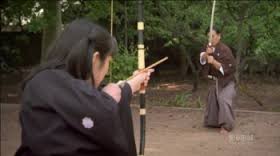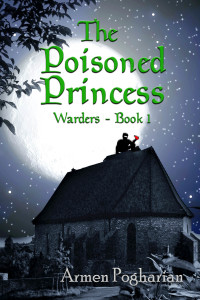I know what you’re thinking two posts in two days, talk about trouble with reality! To be fair, you did sign-up for this or at least knowingly clicked on a link. Also, yesterday’s post was a self-serving plea for you to support my books in the Prize Writer contest. As faithful readers you deserve better than an endless promotional pish-posh. To that end, I offer you a post about combining science and realism in fictional stories. As an added bonus, it’s not about prime or irrational numbers this time. I’m pulling out all stops and going with something a little more action packed – knocking arrows out of the air with a sword.
 With that teaser out of the way, let me cover some background. Many people (mostly non-authors) operate under the belief that writing fantasy or science fiction is easy. After all, if you’re including such fantastic elements as magic and dragons, faster than light travel, or paranormal entities, what’s the point of worrying about biological mechanics or the laws of Physics? There’s certainly some truth to that, but only to a point. Successful fantasy and science fiction stories get the readers to suspend their disbelief and accept the fantastic elements of the tale. Stray too far from the plausible and their imaginations never clear the hurdle.
With that teaser out of the way, let me cover some background. Many people (mostly non-authors) operate under the belief that writing fantasy or science fiction is easy. After all, if you’re including such fantastic elements as magic and dragons, faster than light travel, or paranormal entities, what’s the point of worrying about biological mechanics or the laws of Physics? There’s certainly some truth to that, but only to a point. Successful fantasy and science fiction stories get the readers to suspend their disbelief and accept the fantastic elements of the tale. Stray too far from the plausible and their imaginations never clear the hurdle.
Since I’ve labelled this a ‘science’ post, I feel compelled to share a few fun tidbits about archery. Several factors contribute to an arrow’s lethality. To be sure the shape of the arrowhead and its ability to survive impact are critical factors. The key for us is the kinetic energy (KE) of the arrow. KE equals one half the mass of the arrow multiplied by its velocity squared (KE=1/2 MV^2). Arrows fired from modern bows can reach speeds of 300 feet/second (200mph). The most powerful bow of the middle ages was the Welsh longbow. Estimates of its speed vary widely. The average (not always a good choice) is ~150 feet/second (100 mph). Now we can calculate the time it takes the arrow to reach the target. We need one more piece of data. How much time does our target need to react? Fortunately, the Human Benchmark project has been using the internet to collect data about human reaction times. They’ve collected over 15 million samples, which form a Gaussian-like distribution ranging from 100 to 500 milliseconds, with an average of 262.
Human Reaction Curve
My apologies for the poor image. The people counts on the vertical axis are in increments of 200,000. For a clearer image go to the source Human Benchmark Graphs
Our target has to identify the threat, process the data, and react in time to deflect the arrow before it strikes. If he sees the attacker fire, it will take him a quarter of a second to recognize the threat. He’ll also have to process the flight path and command his muscles to react. Assuming his sword is drawn and ready, that’s another quarter second to react and a tenth of a second to move the sword. That’s about 600 milliseconds to have a chance of blocking the arrow. At 150 feet/second, he’s got a chance to block shots fired from more than 90 feet. Does that pass the reasonableness test? A modern fastball travels as fast as our arrow. The mound is 60 feet 6 inches from the plate, and players manage to hit fastballs.
 Things get more difficult if our target doesn’t see his attacker and if he has to do more than flick his sword. In The Poisoned Princess two characters, Toran a half-elf/barbarian and his barbarian father wield two swords simultaneously. They swing or spin them faster than the eye can track, and use them to deflect incoming arrows. In one scene, Toran sees an assassin aiming and intervenes to protect the target. His father has a more difficult task. He doesn’t see his attacker, so he has to hear the thrum of the bow – say 100 milliseconds and identify the arrow’s flight path – another 250, before he can knock it down.
Things get more difficult if our target doesn’t see his attacker and if he has to do more than flick his sword. In The Poisoned Princess two characters, Toran a half-elf/barbarian and his barbarian father wield two swords simultaneously. They swing or spin them faster than the eye can track, and use them to deflect incoming arrows. In one scene, Toran sees an assassin aiming and intervenes to protect the target. His father has a more difficult task. He doesn’t see his attacker, so he has to hear the thrum of the bow – say 100 milliseconds and identify the arrow’s flight path – another 250, before he can knock it down.
That stretches the archer’s kill zone to 142 feet. They both have the advantage of heightened barbarian battle lust and in Toran’s case keen elven senses to help them. If those abilities put them on the fastest end of the reaction curve, the deadly zone shrinks again and the feat seems at least plausible.
Other Analysis
I’m certainly not the first person to look at this type of problem. The TV show Mythbusters did a program on Ninjas and looked at catching arrows with mixed results Mythbusters Link. Here’s a KPBS NOVA video of a man defending himself from arrows with his Katana, Sword Arrow Video Link.
Neither is a perfect match for my scenario, but all things considered I think there’s enough reality to support my story.
As always, thanks for reading.
Armen
Note Arrow data courtesy of Soar Valley Archers FAQ.



People compare fantasy and science fiction too much. Then there is considerable variation in science fiction. What kind of sci-fi readers are you talking about? I hardly read fantasy, though I still like the Conan stuff I red in my younger days.
Like the Flinx series by Alan Dean Foster I don’t expect accurate advanced science from but I do expect to not have errors in Newtonian physics. Stuff like Arthur C. Clarke’s A Fall of Moondust is a whole different kind of thing. Much of the stuff called science fiction today AIN’T.
You may be right about comparing them too much. I enjoy reading both genres, but so far have only written in fantasy. My science fiction tastes include the classics like Clarke and Andre Norton’s time traders, but also stuff by McDevitt and the slightly harder Benford.
Fantasy has some scope for the impossible (magic, giant flying lizards etc.) but some rules still need to be followed. If a character can catch an arrow out of the air then s/he needs to have damn good reflexes, or magically enhanced ones. In many ways it does depend on the particular character and world – but the writer needs to be consistent
I agree with your point about consistency, especially with respect to magic. Fantastic events are part of the genre, but a little reality check isn’t a bad thing 🙂
Agreed.
Interesting post, Armen. A lot of research has to go into even a fantasy story. Looks like you’ve done your homework. Now I need to go relax my brain. :-/
Thanks, Rita. I’m glad you liked it. I had fun writing it. I didn’t want to get too far into the weeds, but I wanted to at least touch on some of the science involved. It can be hard to strike the right balance.
Excellent! That is precisely why I voted for you book. Keep up the good work.
I’m glad you enjoy my posts. This one took a little longer to put together than most. I guess that’s why I’ve been a bit delinquent in posting about science.